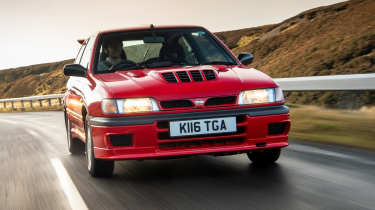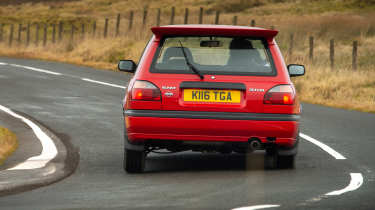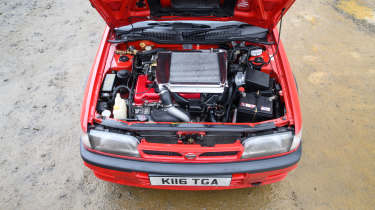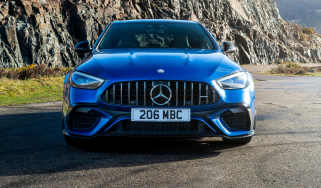Used Nissan Sunny GTI-R (1990 - 1994): review and specs of the unknown rally special
The Nissan Sunny GTI-R is a hidden gem of a homologation special, modest in appearance but far from short on engagement
One of the wonderful things about Group A is that it created legends from some pretty unlikely starting points. The humble standard cars on which homologation heroes were based were often dull to the point of anonymity and it is somehow even better when those run-of-the-mill roots are still very clearly visible in the end product. There is perhaps no better exemplar of this marvellous melding of worlds than the Nissan Sunny GTI-R.
Nissan was one of the companies caught on the hop by the regulation change in 1987 and quickly realised that the 200SX that it had homologated wasn’t going to be cutting any mustard with its naturally aspirated V6 and rear-wheel drive. So it was back to the drawing board, and a few years later, in the midst of Toyota’s Group A heyday, the Sunny GTI-R was launched into the stages.
> Toyota GR Yaris 2025 review – the modern homologation special gets even better
Based on the N14 generation of Sunny – or Pulsar as it was known in Japan – the GTI-R road car was quite the machine. It was launched as the Pulsar GTI-R first in 1990, and there were GTI-RA and RB models, the latter being more stripped-out. The Sunny version arrived in 1992 and its 2-litre turbocharged SR20DET engine had slightly less power (217bhp rather than 224bhp) owing to the European-spec ECU. Nonetheless, it was good for a very impressive 0-62mph time of 5.4sec thanks to the ATTESA (Advanced Total Traction Engineering System for All-Terrain) four-wheel-drive system. This was a mechanical version of the system found on a GT-R of the same period, and with a kerb weight of a mere 1240kg the little Sunny made excellent use of it.
But the glorious thing about the Sunny GTI-R is that it looks like the equivalent of a teapot with tassels. Its little 14-inch wheels, standard arches and humdrum interior look so wonderfully incongruous juxtaposed with the huge rear wing and wildly bulging bonnet. Sadly the bonnet wasn’t quite wild enough for the rally car. The slatted bulge was there to accommodate the needs of the huge intercooler that was on top of the engine. However, because of the heat rising from the engine (particularly on warmer rallies) the intercooler struggled and was nicknamed the ‘interwarmer’. The solution for road-car owners was to move the intercooler to a vertical position in front of the engine, but Nissan couldn’t do this on the rally car without producing another 5000 GTI-Rs to homologate such a major change…
More reviews
Group tests
- Lotus Emira Turbo SE v Alpine A110 GTS – two of the last surviving mid-engined sports cars
- Alpine A290 v Alpine A110 – how much DNA do they really share?
- Ariel Atom 4R v Caterham Seven ‘evo25’: power-to-weight heroes go head-to-head
- Ariel Atom 4 v Caterham Seven 310R v Lotus Elise Cup 250
- £200,000 supercar shoot-out: AMG v Aston Martin v Maserati v McLaren
- Audi Quattro, RS2 and RS3: five-cylinder icons head-to-head
- Who makes the best GT car? Aston Martin v Bentley v Maserati
- Caterham Super Seven 600 v Super Seven 2000
- Corvette Stingray v Porsche Cayman GTS v Audi R8 RWD
- Great Ferrari hypercars driven: 288 GTO, F40, F50 and Enzo head-to-head
In-depth reviews
- Abarth 600e 2025 review – Italy gives the Alpine A290 something to worry about
- Alpine A110 review – the sports car Lotus should be building
- Aston Martin Vantage 2025 review – a thrilling Mercedes-AMG GT and 911 Turbo S alternative
- Used Audi RS2 (1994) review – an unsung '90s hero you can own for £40k
- Audi R8 (2015 - 2024) review – the ultimate soft-focus supercar
Long term tests
- Abarth 695C Turismo Fast Fleet test – living with the charming Italian hatch
- Alfa Romeo Giulia Veloce long term test – can Italy beat Germany?
- Alpina B10: Alpina B10: end of term report
- Aston Martin Vantage (2006) Fast Fleet test – living with a £30k V8 Aston
- Caterham Seven evo25 Fast Fleet test – living with a track car for the road
- Caterham Seven evo Edition revealed – bespoke 420R joins the Fast Fleet
- Cupra Leon 300 Fast Fleet test – living with Spain's 300bhp hot hatch
- Cupra Ateca VZN Fast Fleet test – four months with Cupra's hot crossover
- Cupra Leon Estate 310 4Drive Fast Fleet test – living with the 306bhp hot estate
- Ford Mustang GT
Review
- New Bentley Batur 2023 review – can it possibly be worth £1.65m?
- 2023 Chevrolet Corvette C8 Z06 review – the American 911 GT3?
- BBR Supercharged Mazda MX-5 (ND) 2023 review – tuned 250bhp roadster driven
- MG4 Trophy 2023 review
Reviews
- Abarth 695 75 Anniversario edition 2024 review – a fitting send-off for Abarth’s hot supermini?
- Abarth 500e 2023 review
- AC Cobra 378 Superblower MkIV 2021 review – another V8 Cobra, but with a GM heart this time
- Acura Integra Type S 2024 review – a Honda Civic Type R with added restraint
- Alfa Romeo Giulia review – get one while you still can
- Alfa Romeo 33 Stradale 2025 review – a rare Italian jewel beyond compare
- Alfa Romeo SZ: history, review and specs of an icon
The result was that the Sunny’s only notable success from its two seasons in the WRC (when it was run by NME out of Milton Keynes) was a single podium place. That was in the hands of Stig Blomqvist at the 1992 Swedish Rally, but the event only counted towards the world championship for drivers, not manufacturers.
This in turn might partially explain why the Sunny GTI-R is such a rare car. Just 771 were produced (as against nearly 14k Pulsar GTI-Rs) and of those only 103 were right-hand drive. Nearly 30 years later the number left in completely standard trim, like the one we have for this test, must be astonishingly small. – Henry Catchpole
What it's like to drive
The Sunny illustrates what happened when a manufacturer ruthlessly exploited the Group A regulations, creating a bizarre concoction of humblest shopping hatch and rallying warrior with seemingly little to glue the two disparate halves together. And also how a lack of planning or understanding of those very same regulations could render an entire multi-million-yen project effectively useless before it had even got off the ground.
It feels like eons since cars had interiors as basic and bland as the Sunny’s. The flat cloth seats, scratchy plastic and simple dials are only augmented by a trio of secondary dials for boost, oil temperature and pressure. On its tiny 14-inch wheels it looks meek in one sense, but the bonnet bulge from the driver’s seat is a pretty massive clue as to the qualities of the ‘red top’ SR20DET engine – perhaps best known in the UK under the bonnet of the Nissan 200SX. It’s an absolute cracker: punchy, with little lag and an appetite to rev freely.
It may have been a miserable rally car, but the GTI-R is a formidable road car. It doesn’t even feel overtly four-wheel drive; it’s like some larger-than-life hot hatch that’s time travelled through space to 2025. As it takes apart a particularly tough, twisting road, only the average response of the middle pedal and the sedate driving position betray that it’s nearly 35 years old. You’d not fear even a contemporary hot hatch in the Sunny, it’s such a bizarre but deeply covetable little monster.
Nissan Sunny GTI-R specs
| Engine | In-line 4-cyl, 1998cc, turbo |
| Power | 217bhp @ 6400rpm |
| Torque | 197lb ft @ 4800rpm |
| Weight | 1240kg |
| Power-to-weight | 178bhp/ton |
| 0-62mph | 6.4sec |
| Top speed | 138mph |
| Price when new | c£20,000 |
| Value today | £9000-30,000 |
This story was first featured in evo issue 271.






